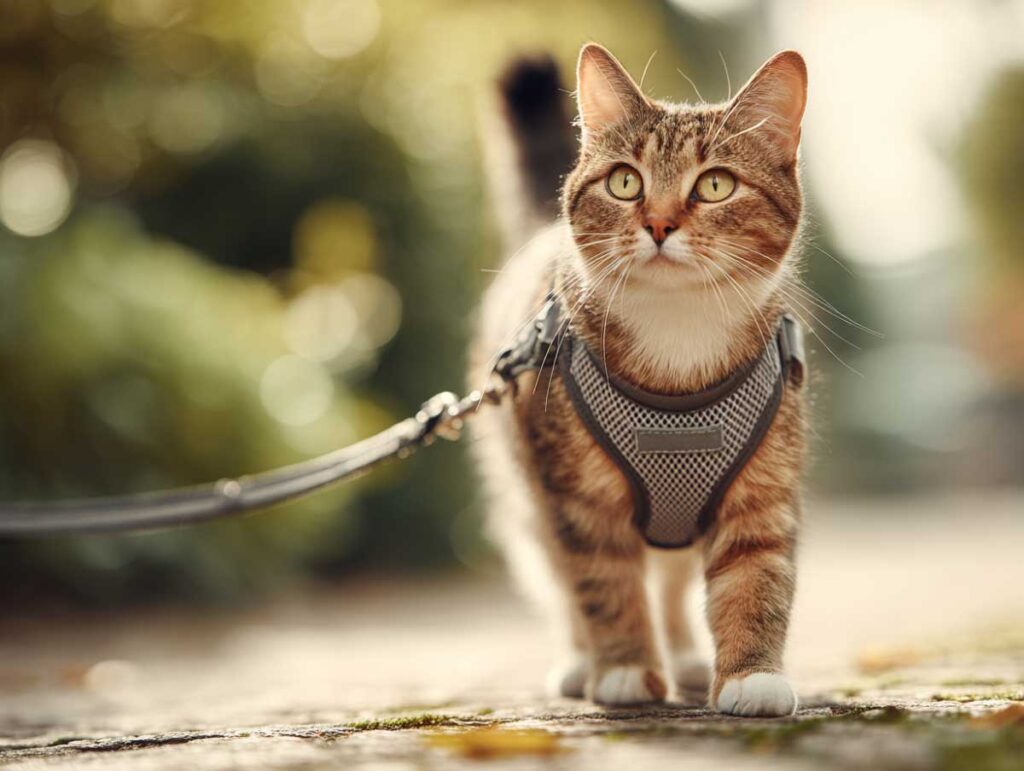Tried putting a harness on your cat lately? One second they are curious, the next they are flopped over like a furry pancake. Or worse, they wriggle backwards under the sofa and give you that look. You know the one.
If you have ever thought, “Maybe I can walk my cat,” and then immediately regretted it, you are not alone. But here is the thing. Cats can learn to walk on a leash. Loads of them do. It just takes the right approach and a cat harness and leash that actually works for them.
So let us talk about how to make that happen. No pressure. No rush. Just real, simple tips that work with your cat, not against them.
Why Even Try Walking Your Cat?
Look, your cat might seem perfectly happy indoors. They nap in sunbeams, chase imaginary bugs, and treat your bookshelf like a climbing wall. But boredom sneaks in, especially for indoor cats. And that boredom can turn into anxiety, fussiness, or even zoomies at 2 am.
A good cat harness and leash changes that. It gives your cat a chance to explore safely, breathe fresh air, and sniff every leaf and bug they come across. You get some fresh air too. And let us be honest, you could both use a change of scene now and then.
How To Choose A Cat Harness And Leash That Actually Works?
Not every cat harness and leash is built the same. If it is bulky, scratchy, or flappy, your cat will hate it. And you will hate it even more trying to get it on.
1. Start with a good fit
Cats are escape artists. If there is even a tiny gap, they will find a way out. Go for something adjustable. It should be snug but not tight. You want to fit one finger between the harness and their fur, no more.
2. Pick soft and breathable materials
Ever worn a scratchy jumper on a hot day? That is how cats feel with stiff harnesses. Look for mesh or padded fabric. Soft material helps your cat feel like they are wearing something familiar, not weird and annoying.
3. Light leash, not a dog leash
Avoid heavy, clunky leads. Choose a lightweight cat harness and leash that moves easily with your cat’s pace. About 1.5 to 2 metres is a good starting length. You want enough space for them to explore, but not so much that they end up in your neighbour’s garage.
The right cat harness and leash feels like part of their body. If they do not notice it much, you are halfway there.
Steps to Train Your Cat Correctly with a Cat Harness and Leash?
Here is where most people mess up. They get excited, clip the harness on, open the door, and expect the cat to strut beside them like a well-behaved dog. Not gonna happen.
Step 1: Let them sniff it
Before anything goes on their body, let them sniff the harness. Leave it near their sleeping spot. Rub a little treat smell on it if needed. You want them to think, “Hmm, this thing is not scary.”
Step 2: Wear it inside, just for a minute
Put the harness on indoors for 2-3 minutes max. Play with them during this. Feed treats. Distract. Then take it off before they start rolling or panicking. You are just introducing the idea.
Step 3: Add the leash indoors
Once they stop caring about the harness, clip on the leash and let it trail behind. Then gently hold it while they walk around. You are not leading yet. You are just tagging along.
Step 4: Go outside, but keep it chill
Try the balcony, a closed terrace, or a quiet garden corner. Not the park. Not the footpath. Avoid barking dogs and loud bikes. Keep walks short at first, like five minutes. Let them sniff, stare, sit, whatever they want.
Using a cat harness and leash is all about trust. Your cat needs to feel like they are in control, even when they are not. That is the secret.
Stuff That Might Go Wrong (And How To Deal)
They freeze and pancake
Totally normal. You put the cat harness and leash on, and they go flat. Do not panic. They are just confused. Take it off, try again later. Add more treats. Patience is your best friend here.
They slip out
Argh, the worst feeling. If this happens, stop everything. Go back and check the fit. Make sure the straps are snug and secure. Some cats are just extra bendy.
They chew or claw at the leash
Happens often. Try distracting them with toys or walk during a time they are naturally more playful. Keep the leash from dragging near their face.
They get scared outside
Too much noise? Windy? Too many smells? Bring them back in. Try again on a quieter day. A good cat harness and leash helps, but it cannot replace calm surroundings and your patience.
How To Know Your Cat Training is Working?
One day, you will clip the harness on, and they will not flop. That is a good sign. Then they will walk across the floor without acting like the carpet is lava. That is an even better sign.
Eventually, your cat will walk out the door, leash trailing, tail up, sniffing the breeze like they were born to do this. And you? You will feel like a cat whisperer.
Look for these little wins:
- No fuss putting on the harness
- Less chewing or biting the leash
- More walking, less flopping
- Curious behaviour outdoors instead of panic
- Celebrate them all. You are doing great.
Final Thoughts
Here is the truth. Walking a cat is not always pretty. It is not always smooth. You will have failed attempts, hilarious mishaps, and days where they just do not want to. But a good cat harness and leash helps you give your pet more freedom, safely. It lets them explore, learn, and feel stimulated without the risks of the wild.





